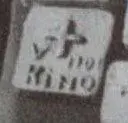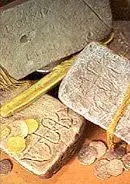SWR,
They are not related (that I know of). The reason I included information about them (as well as the mid1980s gold bars), was to give a bit of history of similar bars found in the region. If I had posted about just the two bars, there would have been a lot of questions easily answered by posting the information about the others, so I included them too.
Basically, it shows a 100 or so year history of known bar finds in the region, so that these two aren't the only ones known to have been found.
Eric,
Well actually I was more interested in the one marked "ALTAR".
I does not seem strange to you that that was put on the ingot?
I'm not certain whether or not you know this, but it is well documented that the King of Spain basically gave the Jesuits free reign over Pimeria Alta for twenty years beginning in 1697. They were free from any Spanish intervention until 1717. Their Indian converts were free from forced labor or paying taxes until that date. That means that there were no Spanish Bureaucrats looking over their shoulders for twenty years.
While it was illegal for them to mine, it would have been difficult for the Spanish to have any idea what was going on. The Jesuits didn't ship their goods through normal Spanish routes. They shipped their goods mostly through either Corpus Christi or Galveston (I don't remember which). They didn't use the normal Mexico City, Havana, etc routes.
But then why are some of those bars dated and dedicated to Kino when he was alive in 1701.
He was the most important Jesuit around. That is a good reason to honor him. As far as him being found out by the Spanish, that was not likely due to previous paragraph.
The first Official report of silver discovered in Arizona close to the Mexican border was in 1736.
You are referring to the "Planchas de Plata" Report. Do you really think that with native silver vein blowouts that left chunks of raw silver in excess of 125 pounds just laying around on the surface, that the people who ran Spain's Mining Schools in the New World would not find them when they were locating missions in those areas? The Spanish had been investigating Pimeria Alta since the 1530s, both officially and unofficially. There were hundreds if not thousands of reports of silver and gold in these areas. Please don't be naive.
Here is a neat picture a friend just sent me:
Please read the first sentence. It seems like the USDA Forest Service thinks the Jesuits had something to do with mineral location there, even though they had the Tumacacori date wrong by about four years (it wasn't founded until 1691). However, they do say "in ABOUT 1687", so I guess it's forgiveable.
Best-Mike











